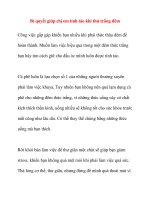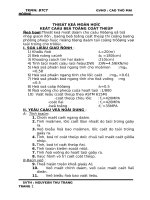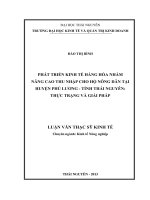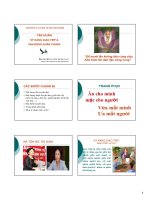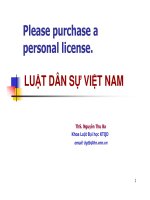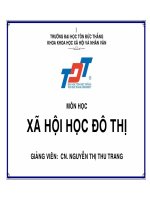Nguyen thu trang ICSE standard english
Bạn đang xem bản rút gọn của tài liệu. Xem và tải ngay bản đầy đủ của tài liệu tại đây (658.3 KB, 52 trang )
Role of Social Enterprise in the Green Agricultural Development of Vietnam
Role of Social Enterprise in the Green Agricultural Development of Vietnam
Nguyễn Thu Trang
Ros Vanchhay
Young Economics Scientist Club
National Economics University
Nguyễn Thu Trang và Ros Vanchhay
Hà Nội, Việt Nam
Role of Social Enterprise in the Green Agricultural Development of Vietnam
Table of Contents
Abstract..................................................................................................................... 3
1. Introduce ............................................................................................................... 5
1.1. The concept of social enterprise .................................................................... 5
1.2. Green agriculture and the role of social enterprises in the development of
green agriculture in Vietnam ............................................................................................ 7
2. Research methodology ......................................................................................... 9
3. Results and discussion ........................................................................................ 11
3.1. Situation of green agriculture development in Vietnam and some countries in
the world ........................................................................................................................ 11
3.2. The role of social enterprises in the development of green agriculture in
Vietnam .......................................................................................................................... 14
3.3. A social enterprise model for the development of green agriculture in Vietnam
........................................................................................................................................ 23
4. Conclution .......................................................................................................... 50
5. Acknowledgments .............................................................................................. 51
References .............................................................................................................. 52
Role of Social Enterprise in the Green Agricultural Development of Vietnam
Tables
Table 3. 1. The consumer choice criteria for agricultural products (from 1 to 7 correspond
to very cheap prices to very expensive prices) .................................................................. 25
Table 3. 2. The consumer choice criteria for agricultural products (from 1 to 7 correspond
to unfriendly to friendly procedure) .................................................................................. 25
Table 3. 3. The consumer choice criteria for agricultural products (from 1 to 7 correspond
to purchase at any location to purchase in the prestigious location) ................................. 26
Table 3. 4. The consumer choice criteria for agricultural products (from 1 to 7 correspond
to the purchase location is very close to the place of purchase very far) .......................... 26
Table 3. 5. The consumer choice criteria for agricultural products (from 1 to 7 are
correspond to bad to good appearance). ............................................................................ 27
Table 3. 6. The consumer choice criteria for agricultural products (from 1 to 7 correspond
to low price to high price).................................................................................................. 27
Table 3. 7. The result of the user binning using Regression Trees according to the value of
criterias .............................................................................................................................. 29
Table 3. 8. The importance of factors affecting consumer confidence in the agricultural
products is safe, hygiene (from 1 to 7 respectively very important to very important) .... 31
Table 3. 9. The result of the user binning using Regression Trees according to the value of
trust reason ......................................................................................................................... 38
Table 3. 10. The level of consumer preference for the elements of the green agroecotourism sector (from 1 to 7 corresponding to very unwanted to highly desirable) ...... 42
Role of Social Enterprise in the Green Agricultural Development of Vietnam
Table 3. 11. The level of consumer preference for the elements of green agriculture
combined ecotourism (from 1 to 7 corresponds very undesirable to very desirable) (Next
1) ........................................................................................................................................ 44
Table 3. 12. The level of consumer preference for the elements of the green agro-tourism
sector (from 1 to 7 corresponds very undesirable to desirable) (Next 2) .......................... 46
Role of Social Enterprise in the Green Agricultural Development of Vietnam
Abstract
The agricultural development in Vietnam is still inadequate due to many units
producing and trading agricultural products do not ensure the technical process, leading to
environmental pollution, causing health risks for people, make reducing the confidence of
domestic and international consumers in Vietnamese agricultural products. Many measures
to support agricultural development in Vietnam have been applied, many new agricultural
models bring high efficiency, but also encountered many difficulties and has not been
multiplied. Green agriculture combined with ecotourism is one such model. The cause may
come from the lack of a core economic component for green agriculture. With the strong
development of both forms and areas of business, social enterprises in Vietnam are
converging to bring all factors to become the leading force and direction in the development
of green agriculture in Vietnam. Through qualitative and quantitative analyzes, the paper
presents the advantages of social entrepreneurship in the development of green agriculture
in Vietnam, and suggests solutions to social entrepreneurship. It is possible to build a green
agriculture model that provides safe, environmentally-friendly products and meets the
needs of today's consumers.
Keywords: social enterprise, green agriculture, ecotourism, agriculture.
1. Introduce
1.1. The concept of social enterprise
According to the study of social enterprise: constraints and opportunities by authors
William Smith and Emily Darko (2014), social enterprise is defined as a business enterprise
with social or environmental objectives. Significant change in commercial orientation.
Trade orientations may vary in some form: to share financial surpluses for customers so
that they may co-own, thereby achieving social objectives, paying more than market prices.
suppliers, paying employees above the market level or limiting profits to ensure social
objectives, cross subsidization for a group of customers to ensure social goals, subsidies
from the State or non-governmental organizations for business activities to ensure social
objectives.
5
Role of Social Enterprise in the Green Agricultural Development of Vietnam
In Social Enterprise in Vietnam: Concept, context and policies by Nguyen Dinh
Cung et al. (2012), social enterprise is defined as an enterprise that has the following
characteristics:
- Social responsibility is a top priority
- Use business activities, healthy competition as a tool to meet social goals
- Reinvest the profits from business activities into organizations, communities and
social objectives.
Research shows that most social enterprises have some typical characteristics:
(i) a social ownership structure;
(ii) income from business and donations;
(iii) impact assessed on both economic and social dimensions;
(iv) serve the needs of the poor, vulnerable and marginalized groups.
(v) initiative with a “bottom – up” approach;
(vi) open and link; (vii) close links with social entrepreneurs;
(viii) Social enterprise employees are “social workers” (paid non-volunteers).
Social enterprises are often recognized as “hybrid” models between two types of
non-governmental organizations, non-profit organizations and enterprises. The social
enterprise model can be applied to a wide variety of legal entities, such as nongovernmental organizations, limited liability companies, joint – stock companies,
cooperatives, associations, clubs...Notably, social enterprises are based on social initiatives
in which business activities are used to provide sustainable solutions to the social, enabling
the Figures are more advantageous than others in terms of organizational and financial
autonomy, efficiency, and scale of social impact.
Article 10, Chapter I of the Enterprise Law (amended) of 2014 stipulates that social
enterprises must meet the following criteria:
a) Being an enterprise registered for establishment under the provisions of this Law;
b) Objectives of activities to solve social and environmental issues for the benefit
of the community;
6
Role of Social Enterprise in the Green Agricultural Development of Vietnam
c) To use at least 51% of the annual profits of the enterprise for reinvestment due to
achieve the social and environmental objectives as registered.
In general, the concept of social entrepreneurship in countries and at times has some
differences, but there is a commonality about the purpose of the enterprise’s operation is
to solve social problems and environment.
1.2. Green agriculture and the role of social enterprises in the development of green
agriculture in Vietnam
In the current context, as the world faces increasingly severe climate change and
environmental pollution, rapid growth is no longer the first goal of any economy. Countries
are trying to find a way to bring sustainable development to the economy. Green growth
has become a more common term in strategic planning around the world. The greening of
agriculture, by Andy Hall and Kumuda Dorai (2015), introduces the concept of green
businesses using technologies, methods to reduce the load of known toxins. In agricultural
production, replaced by safer alternatives, protection of water, land and air, conservation
of natural habitats, and reduction of non-renewable energy use during the culture cycle. In
general, existing or new measures can be used to improve resource efficiency and
ecological efficiency. So green agriculture has broader objectives and criteria for safe
agriculture or agriculture. Safe agriculture, clean agriculture interesting in the quality of
output, so as not to harm the health of consumers. However, green agriculture also focuses
on the ecological environment where agricultural produce is produced. To achieve this, the
use of hazardous substances in the production process needs to be minimized and properly
regulated. In contrast, if the toxins around the habitat of plants and animals are reduced,
the product is also safer, avoid causing environmental pollution, causing harm to the health
of the surrounding people. and negatively affect the resources for later production. The
methods that can be used in green agriculture are biotechnology, organic agriculture, etc.
There are many studies that argue that green agriculture is important, building the
foundation and promoting green growth for each country. family. In Vietnam, green
agriculture has a bigger role to play, which is to limit the distortion of agriculture - to avoid
7
Role of Social Enterprise in the Green Agricultural Development of Vietnam
the emphasis on productivity without quality assurance, hygiene, food safety, Green
agriculture will help farmers, businesses find new directions in production, supply products
to the market, bring more benefits to consumers and protect the environment. Although it
has appeared in many parts of the world and is known in Vietnam, green agriculture has
not been replicated nationwide. Due to promote green agriculture in Vietnam, it is
necessary to find a leading force in the orientation and development of green agriculture.
Compared with normal commercial enterprises, social enterprises are more suitable and
have more advantages in this field. The paper examines the role and advantages of social
enterprises in the development of green agriculture in Vietnam.
To date, there have been several studies on green agriculture and the role of social
enterprises in the development of a country's agriculture. William Smith and Emily Darko
(2014) point out the challenge – the opportunity of social enterprises in Vietnam and Kenya
in the field of agriculture and medical. The survey found that majority of social enterprises
in Vietnam are small or very small, although they provide special products, special markets
and receive a lot of support from the state and non – governmental organizations. However,
social enterprises face many difficulties. The authors have pointed out some difficulties for
social enterprises in agriculture and health in Vietnam and Kenya such as difficulties in
accessing finance from banks, lack of intermediary referrals for entrepreneurs lacking of
human resources due to the difficulty of competing for employees with normal commercial
enterprises, the provision of special products or participation in special markets also causes
difficulties for social enterprises, social enterprises also face difficulties in terms of
policies, legal regulations and organizational structure. Despite some difficulties, the study
also confirmed that social entrepreneurship is very relevant to the provision of specialized
agricultural and medical products in both Vietnam and Kenya. In the recent study of Social
Enterprises in Organic Farming and Their Usage, author Yixin (Sarah) Zhang (2016)
affirmed the superiority of social enterprise in comparison to commercial enterprises in
China. The purpose and mode of operation of organic agriculture products are marketed,
and the social entrepreneurship (mainly in the form of farmer association) These include:
difficulty in accessing and gaining consumer confidence, product quality management by
8
Role of Social Enterprise in the Green Agricultural Development of Vietnam
participating farmers, and social pressures on some young farmers returning. when the
university education personnel. The author has emphasized the role of information
technology, especially the use of general information pages, social networking for market
access and gaining trust from consumers of social enterprises.
This paper also explores many other relevant studies and performs qualitative and
quantitative analyzes such as stratified tree algorithms to produce a green agricultural and
green traveling model suitable for Vietnam and can be developed. by social enterprises.
Qualitative and statistical analysis is used to identify the strengths of social enterprises in
line with the development of green agriculture in Vietnam. The quantitative method used
is the stratified tree algorithm which can classify consumers with different tastes very
effectively and look for important factors affecting the trust and choice of consumers. for
Vietnamese agricultural products.
2. Research methodology
This paper uses qualitative and quantitative methods. Qualitative methods such as
policy research, business interviews, and analysis of results from previous studies. The
author conducted a direct interview with farmers Pham Van Thu in the poultry industry and
Mr. Nguyen Trung Hau in the livestock industry in Vinh Bao district, Hai Phong city on
the production habits. Evaluate the agricultural market in Vietnam and advantages and
disadvantages encountered in the production of safe agricultural products. In addition, the
research also explored the difficulties and advantages of start-up businesses in clean
agriculture and safe agriculture through means such as social networking, surveying, etc.
Regression Trees is used as a classification algorithm. Regression Trees is a
classification algorithm commonly used in data research. The idea of the algorithm is that
at each step dividing the observations containing the value of the dependent variable into
two groups, the criterion of grouping is based on the value of an independent variable at
that observation. The conditions of the independent variable at each division step are
calculated so that dividing into two groups ensures a certain difference between the
observations in the two groups. The result will be that the observations are divided into
9
Role of Social Enterprise in the Green Agricultural Development of Vietnam
groups, each of which has distinct characteristics about the value of some independent
variables. This algorithm is useful for classifying consumers with different characteristics
and needs. In class, it is necessary to maximize I [C, X] - information about X features. For
Regression Tree, it is necessary to maximize I [C, Y], where Y is the response variable and
C is variable says that the leaves of the tree end here. At each iteration step, find a binary
question that maximizes the information about Y, for the node in the tree. Accuracy
determines the criteria for stopping. That criterion can be the sum of the squares for a fault
in a tree. Sum of squares for a tree error is computed as follows:
∑
𝑆=
∑(𝑦𝑖 − 𝑚𝑐 )2
𝑐 ∈ 𝑙𝑒𝑎𝑣𝑒𝑠 (𝑇) 𝑖 ∈𝑐
Where: 𝑚𝑐 =
1
𝑛𝑐
∑𝑖 ∈𝑐 𝑦𝑖 <=> 𝑆 = ∑𝑐 ∈𝑙𝑒𝑎𝑣𝑒𝑠 (𝑇) 𝑛𝑐 𝑣𝑐
Where: 𝑣𝑐 is variance of leaf c.
Algorithm to create a division to minimize S.
Here is the basic algorithm:
1) Start with a node containing all the observations. Volume and S.
2) If all the observations in a node have the same value for all input variables then
stop. If not, search across all binary distributions of all variables that reduce S as much as
possible. If the largest decrease in S is less than a certain threshold or the number of
observations in a node is less than a certain value, then stop.
3) Algorithm can be stopped too soon due to the control criteria or the tree grows
too large. The Cross - Validation method checks at the two nodes that the parent should
merge or not.
The regression tree is used in the R-3.4.1 software with the rpart function in the rpart
package. The purpose of the Regression Tree in the article is to group customers with the
same criteria and characteristics. The averaging of the dependent variable in each group
predicts the value of the dependent variable based on some of independent variable values.
10
Role of Social Enterprise in the Green Agricultural Development of Vietnam
The data used for the study was collected from some of sources, from previous
studies, government gateways, the General Statistics Office and a survey of 104
Vietnamese consumers for agricultural products. clean.
3. Results and discussion
3.1. Situation of green agriculture development in Vietnam and some countries in the
world
Green agriculture has been applied and developed in several countries around the
world, including some Asian countries that have many cultural and economic similarities
to Vietnam. In Thailand, green agriculture combined with ecotourism, sharing of
production experience has been widely applied. Thailand also has a good link between
university students, scientists and farmers to use land, water and resources more effectively.
Japan is a leader in innovation and innovation in agricultural production. It is also the
leading developer of environmentally friendly organic agriculture in Asia. Many
Vietnamese scientists have applied to Vietnam the varieties and methods of agriculture
from Japan.
In Vietnam, green agriculture has been known but has not been widely applied. This
is due to a variety of reasons. Green can be attributed to the fact that green agriculture needs
to focus on maintaining a safe and environmentally friendly production method while
maintaining a profitable level. In the market of agricultural products in Vietnam, highquality, low-quality products are difficult to distinguish, with many levels. Different prices
for a product and proven ineffective source, getting the trust of consumers is really a
difficult thing.
Vietnam Development Report 2016 Vietnam's Agricultural Transformation:
Increasing Value and Reducing Inputs The World Bank has highlighted the current state of
agricultural development in Vietnam: "Vietnam is inferior to other countries the use of
agricultural land, labor and water; Compound factor productivity has grown rapidly, but
growth has slowed down in recent years; the gap between agricultural and non-agricultural
incomes is growing and income inequality in rural areas is increasing; Most of Vietnam's
11
Role of Social Enterprise in the Green Agricultural Development of Vietnam
agricultural products are sold in the form of raw materials at lower prices than others due
to poor quality and some other causes. Even in the country, food safety is becoming a
matter of concern; Much of Vietnam's agricultural growth has so far been based on
expanding production or intensifying use of land and other natural resources, as well as
using a great deal of fertilizers and other chemicals in agriculture; Agricultural growth is
accompanied by negative impacts on the environment such as deforestation, the destruction
of aquatic resources, land degradation and water pollution; Vietnam's agricultural growth
relies heavily on labor, natural resources and chemicals in production; Agriculture is in
competition with labor, land and water resources because of urbanization, industrial and
service development; Increased labor costs adversely affect competitiveness, which is
based on the advantage of low production costs of raw agricultural products. Excessive use
of inputs and natural resources; some of environmental issues are hindering productivity
growth and Vietnam’s competitive position in the international market. “(Excerpted from
Vietnam Development Report 2016 Vietnam Agricultural Change: Increasing Value,
Reducing input).
The situation of environmental pollution and the level of understanding and
application of green production are clearly stated in the report: “The environment is
degrading in many forms in key agricultural regions of Vietnam. For example, expansion
of shrimp farming in the Mekong Delta has led to widespread destruction of mangroves
and pollution of water resources. In intensive farming, farmers often use too many
chemicals and antibiotics for shrimp ponds with too high density. Wastes from shrimp
ponds also contain large amounts of organic waste that contaminate nearby freshwater and
coastal waters. Extension of coffee and rubber cultivation in the Central Highlands also
contributes to the destruction of forests, the loss of biodiversity, and the depletion of
groundwater. Livestock is fast growing but also contributes to water pollution and
greenhouse gas (GHG) emissions. Rice paddy degrades soil, pollutes the water, damages
biodiversity and increases greenhouse gas emissions. Many factors contribute to the
environmental impact of agriculture is increasingly serious. These factors can be grouped
into three groups:
12
Role of Social Enterprise in the Green Agricultural Development of Vietnam
(i) Policy failure and state management
(ii) market failure
(iii) knowledge and information gaps.
- Vietnam's agricultural policy is mainly aimed at improving productivity due to
achieve food security, economic growth and export. Policy orientation has encouraged the
expansion of area, increased intensive farming, increased use of materials and other factors
to improve production capacity. The state seeks to protect farmers but does not care for the
environment. Even when the policy of the State gives priority to environmental protection,
the local government still seeks to expand the area and intensively to achieve the goal of
growth and revenue. Cross-sectoral coordination is also ineffective in enabling the goal of
developing green agriculture into practice.
- In general, the producers do not have to pay the full cost of the resources they use;
And they do not have to bear the cost of “environmental footprints”.” Groundwater and
water supplied by the irrigation system are not fully charged or even free. For many
farmers, “dirty” production in the immediate future may be more profitable because of the
environmental costs that either the community or other farmers downstream suffer. The
fragmented production structure results in very high transaction costs, including technical
support costs for sustainable farming practices and compliance monitoring by farmers with
state or market standards. Except for some exceptions, distribution channels and consumers
have never named poor producers or praised standard manufacturers. Consumers are still
unsure or unaware of the environmental impact, so their pressure is low for producers to
change their farming practices. Most of Vietnam's agricultural exports are in the raw form
so the end consumer is unaware.
- Knowledge about green agriculture in Vietnam is slowly forming but still limited.
There is still a shortage of knowledge about vulnerability in some areas - for example
groundwater and surface water in the Central Highlands. Knowledge and level of
awareness of farmers on technical solutions as well as capital requirements are uneven
especially in areas where extension services are not developed and farmers’ main source
of information are traders of agricultural materials. The agricultural research system has
13
Role of Social Enterprise in the Green Agricultural Development of Vietnam
for years focused on improving productivity rather than focusing on solutions and
technologies that reduce the "environmental footprint" of agriculture.
Survey data from the General Statistics Office and collected, presented in Vietnam
Development Report 2016 Vietnam Agricultural Change: Value Added, Decline in Inputs,
Policy, Market and Popularity knowledge and information in Vietnam have not created
favorable conditions for green agriculture. Producers do not have enough pressure to follow
a production process that ensures quality and is environmentally friendly, end consumers
can not distinguish the quality of products when selected, this is a social enterprise that has
become a leading force in the development of green agriculture, because it is a force to
receive special support. Identify the social and environmental objectives and easily link
farm households and farms to uniform standards, change production methods in the
direction of green agriculture.
3.2. The role of social enterprises in the development of green agriculture in Vietnam
As stipulated in the Enterprise Law (amended) in 2014, there are about 20 officially
registered social enterprises in the whole country. However, the organizations with the
characteristics of the business are a much larger number, up to 200 enterprises according
to British Council statistics and Center for Social Initiatives Promotion (CSIP). This figure
may be less than the real development of the number and activity of social enterprises in
Vietnam today. A large of social enterprises are well suited to linking and sharing values
due to develop green agriculture in Vietnam. Vu Thi Quynh Anh et al. (2014) studied some
of the typical social enterprises in the agricultural sector in Viet Nam, including:
Evergrowth cooperative with about 3000 beneficiaries, KCT Center Thai Binh with about
10,000 beneficiaries, Huu Duc cooperative with 1403 beneficiaries, Huong Hoa Cassava
Starch Company (SEPON) with about 9000 beneficiaries, VRAT Co. Ltd. with 60
beneficiaries, People’s Credit Fund Liên Nghĩa with 10763 beneficiaries. Thanks to the
social and environmental goals, social enterprises receive more support from the
government and non-governmental organizations than the commercial ones. The amended
14
Role of Social Enterprise in the Green Agricultural Development of Vietnam
Business Law of 2014, chapter I, article 10 outlines the rights and obligations of social
enterprises in Vietnam:
Clause 2. Apart from the rights and obligations of enterprises under the provisions
of this Law, social enterprises shall have the following rights and obligations:
a) Maintaining the objectives and conditions specified at Points b and c, Clause 1 of
this Article throughout the course of operation; In cases where the operating enterprises
wish to transform into social enterprises or social enterprises wishing to abandon their
social and environmental objectives and not use profits for reinvestment, the enterprises
must notify such to the competent bodies the right to carry out procedures in accordance
with the law;
b) The enterprise owners or managers of social enterprises shall be considered,
facilitated and assisted in the granting of permits, certificates and relevant certificates
according to the provisions of law;
c) To mobilize and receive funding in various forms from individuals, enterprises,
non-governmental organizations and other organizations in Vietnam and abroad to cover
management and operational expenses. the dynamics of the business;
d) Not to use mobilized financial supports for other purposes other than to cover
management expenses and operation expenses for settlement of social and environmental
problems which enterprises have registered;
e) In case of receiving incentives or supports, social enterprises must annually report
to the competent agencies on the operation of enterprises.
Clause 3. The State shall adopt policies to encourage, support and promote the
development of social enterprises.
From the benefits and the support that can be received, social enterprises have a lot
of advantages in developing green agriculture in Vietnam compared to conventional
commercial enterprises. As it is known, green agriculture in Vietnam is a relatively new
field and needs a lot of new elements to develop, from capital, people, technical processes,
activities and management. As any business participant in this market must be prepared to
compete in the market. From the data collected and some related research articles, the
15
Role of Social Enterprise in the Green Agricultural Development of Vietnam
article assesses the difficulties and advantages of commercial enterprises and social
enterprises in the development of green agriculture in Vietnam. of social enterprises
compared to normal commercial enterprises in this field.
In terms of production methods, large commercial enterprises often invest in modern
technology thanks to the abundant capital. Currently, many large enterprises such as
Vinamilk, TH True Milk, Hoa Phat, Hoang Anh Gia Lai, VinGroup, Hung Viet Green
Agriculture Joint Stock Company have been involved in the green agricultural market in
Vietnam. The common feature of these enterprises is the large investment in production
technology development.
Applying technology to agriculture with modern machinery will increase
productivity and ensure product safety, but may not take advantage of available resources
in nature and require an initial capital. This is too big for most farmers and farms in
Vietnam. Green agriculture, by effectively utilizing natural resources and conditions, can
reduce dependence on technology. In addition, with the goal of maximizing profits,
commercial businesses will typically focus on productivity. Some small commercial
enterprises do not have enough capital to apply high technology to ensure that the supply
of the market can be applied to insecure methods that degrade the quality of agricultural
products. Mr. Pham Van Thu, farmer’s owner in poultry farming in Hai Phong, said that
after graduating from university, he returned to his hometown, wanting to apply Japanese
technology in agricultural production. Even though they have learned theories but have not
invested enough capital, the friends who open the farm as well do not want to cooperate
with him to change the technology. So, he decided to produce by the traditional method,
mainly by experience. Asked about safe agricultural production, he said he did not really
follow a standard procedure for safe agricultural production, as costs exceeded sales, yet
he was comfortable with farm produce. but produced by myself. Mr. Nguyen Trung Hau in
Hai Phong, working in the field of animal husbandry also said that his farm products are
safe agricultural products produced without the use of chemicals, such as animals not using
public food. It is safe to use natural foods, non-plague animals, healthy growth. Mr. Hau
also said that the farm produce itself is of course more secure than other agricultural
16
Role of Social Enterprise in the Green Agricultural Development of Vietnam
products on the market, whether it is the big brands. Hai Phong has also started to develop
safe farming systems, applying technology in some districts such as Vinh Bao, Tien Lang...,
but these agricultural areas have no direction of green agriculture and agricultural products.
These areas do not really provide enough for people in the city. A similar situation in the
case of Hai Phong also occurs in many provinces and cities in the country. Vietnam's
agriculture, although developed with the focus on quality, still takes the safety of
consumers as the main purpose, the implementation of the objectives of environmental
protection and agricultural development. Sustainability is not paid attention. Particularly
referring to a product is “clean vegetables” also have many concepts such as safe
vegetables, VietGAP clean vegetables and organic clean vegetables. “Safe vegetable is a
vegetable produced with technology that is still using agricultural chemicals but more
limited and more reasonable, and products to consumers must ensure three safety criteria
for NO3 residues heavy metals, pesticide residues, microbial residues do not exceed the
permitted levels and ensure traceability. This type of food must meet the standards of food
safety. This is a widely consumed vegetable at clean vegetable stalls, clean markets or
agricultural markets. VietGAP Vegetables are vegetables produced and processed with
clean technology according to VietGAP certified process. In this category, we attach
importance to safety standards, environmental sanitation, origin. Products are consumed in
supermarkets, restaurants, high-end kitchens and for export. Organic clean vegetables are
produced with the technology without using agricultural chemicals, in a clean and safe
ecological environment, the product is absolute safe with consumers, no toxic residues. and
ensure the traceability of origin. By 2016, only 162 hectares of VietGAP certified safe
vegetables will be certified.” (For the whole community to enjoy fresh vegetables, Truong
Quoc Tung (2016)). This is a very low rate compared to the current agricultural land of
Vietnam.
On the ability to link and compete in the market, small and medium enterprises and
farmers have difficulty in orienting and developing green agriculture due to insufficient
resources and access to information. Linking, management is weak. In 2011, the country
had 8.9 million farm households, 126,000 farms but only 6302 cooperatives, indicating that
17
Role of Social Enterprise in the Green Agricultural Development of Vietnam
most of the agricultural production was still farmer households, the ability to switch and
link not tall. Large enterprises can invest in high-tech agricultural production and employ
a large of skilled workers, but there is no common agreement among these enterprises due
to competition and difficulties in linking. They do not fully believe in the quality of
agricultural products produced by these enterprises, in addition they are afraid of a high
price. Clean agricultural products are sold in supermarkets, chain stores have not attracted
a large of middle- or low-income people because of their lack of trust and not compete with
prices. of other products. Of the respondents in the low and middle – income groups, only
39 out of four (37.5%) went to supermarket chains or shopping centers to buy agricultural
products. Of these, 24/39 (61.54%) are regularly buying agricultural products at small
markets and shops, where product quality is difficult to control. And only 22 of 39 (56.41%)
of the consumers surveyed or to the chain stores, supermarkets because it is believed to be
the place to provide safe agricultural products. This shows that consumers do not fully trust
agricultural products in supermarkets, trade centers, chain stores are selling agricultural
products safely. High prices while demonstrating ineffective quality are some of the
reasons that large scale commercial enterprises have not had a full advantage in developing
green agriculture in Vietnam.
Unlike business enterprises, social enterprises define social and environmental
goals, so it is easy to find and pursue safe manufacturing practices for workers, quality
assurance, hygiene for the product and avoid environmental pollution, green agriculture is
the way many social enterprises can direct. Due to do this, social enterprises need to have
sufficient capital, can not depend on support from the State and non-governmental
organizations, so businesses will tend to link households. farmers together to build social
enterprises in the form of cooperatives, or social enterprises linked together to solve the
problem of capital.
Vietnam Development Report 2016 Vietnam Agricultural Transformation:
Increasing value, reducing inputs has provided data from the agricultural census on "types
of production organization as follows:
18
Role of Social Enterprise in the Green Agricultural Development of Vietnam
- Agricultural households include 8.9 million households in 2011 (10.1 million in
2001).
- The farm, including 126 000 units in 2011 (61000 in 2001).
- Agricultural enterprises, including 2536 units (2136 in 2001). Although most of
the agricultural enterprises are private enterprises, nearly two thirds of the total investment
capital held by state-owned enterprises or majority ownership.
- Agricultural cooperatives, including 6302 units (7237 in 2001).
- Other facilities, including stations managed by the CPC and other agencies, foreign
businesses and individuals.
Approximately 90% of agricultural land belongs to agricultural households and
farms, 6% belongs to enterprises, the rest belong to other establishments. Most of the
agricultural households are very small. The smallest group, less than 0.2 ha, accounted for
26% of total households in 2001 and 35% in 2011. The largest group, over 2 hectares,
increased slightly from 5% to 6. %. In fact, many small-scale producers have achieved very
high returns - measured by average yield per hectare of land and other resources. For some
crops, the results show that the effect and magnitude of inverse correlation, in some Ushaped interrelations, is a gradual increase in efficiency. that, then decrease as the scale
continues to increase. But this “small good” concept does not into account the risk
management of household heads, the transaction costs when collecting products of many
small households to bring to market. In the case of Vietnam, small-scale farmers are not as
productive as scattered land. In many places the land is divided equally for everyone. Land
of good quality and bad is divided equally. As a result, households have 3 or 4 plots, even
more, and the plots are far apart. That affects labor productivity and management
efficiency. "Data on agricultural production patterns and land use rates of different types
show that fundamental changes in Vietnamese agriculture Improving the performance of
farm households and farms is essential. Linking farmer households and farms into social
enterprises will make it easier to manage the quality of agricultural products and protect
the environment. More than 6,000 agricultural cooperatives are a large force for green
agriculture in Vietnam. Social enterprises in the form of agricultural cooperatives can take
19
Role of Social Enterprise in the Green Agricultural Development of Vietnam
advantage of rural human resources, inherit the advantages of traditional farming methods
and minimize harmful farming practices such as burning the use of insecticides and
pesticides in contravention of regulations ... The form of cooperative linking farmer
households can overcome some problems of capital source and work. make people in the
countryside. One of the most distinct advantages of social enterprises in comparison with
conventional trading enterprises in green agriculture development is that they can receive
timely support from the state and non-governmental organizations. Since green agriculture
is a widespread field in Vietnam, green products need to enter the market from the very
first step, gaining consumer confidence is a great thing. The same challenges faced by green
producers. With support for product certification, licensing and other certifications, social
entrepreneurs can more easily access the market. At the same time, with the promotion of
social and environmental goals and activities, social enterprises will gain consumer
confidence faster than other commercial enterprises. The results of the survey of middleincome consumers show that consumers’ awareness of the clean agricultural product brand
of large, medium and small traders, and agricultural cooperatives is high. distinctly
different. Below is the statistics describing the level of knowledge and belief of people in
some clean agricultural products and safe agricultural products in the country. In measure,
value 1 is unknown, 2 is known but not buy, 3 is buy, 3 is buy, 5 is always buy.
20
Role of Social Enterprise in the Green Agricultural Development of Vietnam
Table 3.1. Investigate the level of understanding and information of people with some
brands of clean agricultural products, safe agricultural products
Label
Min
Max
Mean
Dalat GAP
1
4
1.798
Orfarm (Hanoi)
1
4
1.615
Organica
1
3
1.385
Ravi (Hanoi)
1
5
1.442
Bác Tôm
1
4
1.692
An Phú (Dalat)
1
5
1.49
Liên Thảo (Hanoi)
1
4
1.337
Rau cười Việt Nhật
1
4
1.404
Big Green (Hanoi)
1
5
1.798
Cầu Đất Farm (Ho Chi Minh City)
1
5
1.452
VinEco (VinGroup)
1
5
2.625
1
5
2.192
1
5
2.827
Agricultural cooperatives in provinces and
cities
Small farmers
Source: survey data
21
Role of Social Enterprise in the Green Agricultural Development of Vietnam
By comparison, on average, agricultural cooperatives and small farmers have a very
high average, ranging from 2 to 3, indicating that the majority of low and middle – income
consumers are aware and selective. buy agricultural products from cooperatives and small
farmers, though not as powerful as other businesses. Among the commercial enterprises
surveyed, VinEco (VinGroup) is known and chosen to buy the most, because this is the
strong brand of Vietnam today. Da Lat GAP brand has 9/104 (8.6%) surveyed people
choose to buy products, Orfarm has 3/104 (accounts for 2.88%) surveyed people often
choose to buy products, brand Organica Only 11 out of four (10.57%) of the surveyed
people choose to buy, Ravi (Hanoi) only 6/104 (5.77%) surveyed people often or always
choose to buy Uncle Tum is quite invested in marketing but only 3/104 (2.88%) surveyed
people often choose to buy products here and up to 33/104 (accounted for 31.73%) people
are Surveyed but did not choose to buy products of Uncle Tom. For cooperatives, the rate
of purchase was very high, 41/104 (39.42%) were surveyed. The above statistics show that
social enterprises have a greater advantage for commercial enterprises in the development
of green agriculture in Vietnam.
Although there are many advantages, social enterprises face some of specific
difficulties, such as the difficulty of accessing financial resources from banks, the
introduction of intermediaries from home in the same time, penetrating in the market with
new products also makes social enterprises difficult because they do not have experience
in the first steps (According to Social Enterprise in Vietnam: Concept, context and policies
of author Nguyen Dinh Cung et al. (2012)). If social enterprise wants to operate in the field
of green agriculture, besides the basic difficulties mentioned above, businesses also face
the guiding and management of workers, especially social enterprises in the form of
agricultural cooperatives. Difficulties sometimes come not only from the employees but
also from the business owner. If the social entrepreneur is a social worker or a
philanthropist, then starting business Market rules and out competing strategies can be no
small obstacles. Currently, building a common model for green agriculture development to
promote the advantages and reduce difficulties for social enterprises is very necessary.
22
Role of Social Enterprise in the Green Agricultural Development of Vietnam
3.3. A social enterprise model for the development of green agriculture in Vietnam
As mentioned above, social enterprises have special advantages over conventional
commercial enterprises in terms of maintaining appropriate production methods, linking
and unifying the goals of green agriculture development in Vietnam. However, in the
context of agricultural products on the market today it is difficult to distinguish low or high
quality with variation in locations selling, price, delivery form, and the information about
food is unclearly. Safe and hygiene is spreading on the mass media, it is very difficult to
gain the trust of consumers and bring the products of green agriculture to the people.
Whether granted a certificate of safety, proof of provenance, extensive supply chain
investment or sale at supermarkets, the large commercial center is unlikely to gain the trust
of the community. Vietnamese consumers. Firstly, the certification in Vietnam usually takes
the form of a product, not a whole, of conducting inspections in a certain time, which can
not make people believe in most of the agricultural products of a given enterprise. The
market is safe. Second, the provenance of the product does not mean that people believe in
the production process of the product. Thirdly, at some supermarkets, trade centers, there
have been some unsafe products appearing, so consumers can not fully trust the quality of
agricultural products in supermarkets, trade Center. Obtaining consumer confidence has
been difficult, but whether green agricultural products may have prices that will make
consumers willing to pay or not. Most middle-income and low-income Vietnamese can
regularly go to supermarkets, shopping centers and chain stores to buy green farm produce
at a higher price than other agricultural products. wholesale markets, small markets...Green
agricultural production is an area that requires a lot of effort from social enterprises, so
businesses need to understand the tastes of consumers, “Sell the market need, not sell what
you have”. Social entrepreneurship before unification of a green agricultural development
model needs to study how to gain consumer confidence, how consumers accept the price
of produce how green products can compete in the marketplace. Below is a survey of the
factors that affect consumer confidence in an agricultural product.
23
Role of Social Enterprise in the Green Agricultural Development of Vietnam
Definition of variables:
Variable names
Mean
Value
NON_MUST_SAFE
Hygiene safe
1 - 7 (Very insecure - Very safe)
UNFRENDLY_FREN
Eco-friendly production
1 - 7 (Unfriendly production process –
DLY_ENVIROMENT
process
Environment friendly production process)
ANY_TRUSTFUL_P
Prestigious location
1 - 7 (Any location - Very prestigious
LACE
BAD_GOOD_APPEA
location)
Appearance
RANCE
1 - 7 (Very bad appearance – Very nice
appearance)
LOW_HIGH_PRICE2
Price
1 - 7 (So low price – So high price)
TOO_NEAR_FAR
Distance
1 - 7 (So near – So far)
NON_MUST_SAFE
Hygiene safe
1 - 7 (Very insecure - Very safe)
UNFRENDLY_FREN
Eco-friendly production
1 - 7 (Unfriendly production process –
DLY_ENVIROMENT
process
Environment friendly production process)
ANY_TRUSTFUL_P
Prestigious location
1 - 7 (Any location - Very prestigious
LACE
BAD_GOOD_APPEA
location)
Appearance
RANCE
1 - 7 (Very bad appearance – Very nice
appearance)
LOW_HIGH_PRICE2
Price
1 - 7 (So low price – So high price)
TOO_NEAR_FAR
Distance
1 - 7 (So near – So far)
24
Role of Social Enterprise in the Green Agricultural Development of Vietnam
Table 3. 1. The consumer choice criteria for agricultural products (from 1 to 7 correspond to very
cheap prices to very expensive prices)
NON_MUST_SAFE
Frequency of choice
Probability
1
1
1%
2
1
1%
3
8
8%
4
10
10%
5
19
18%
6
31
30%
7
34
32%
Source: survey data
Table 3. 2. The consumer choice criteria for agricultural products (from 1 to 7 correspond
to unfriendly to friendly procedure)
UNFRIENDLY_FRIEN
DLY
1
Frequency of choice
Probability
6
6%
2
14
13%
3
14
13%
4
25
24%
5
17
16%
6
12
12%
7
16
16%
Source: survey data
25
